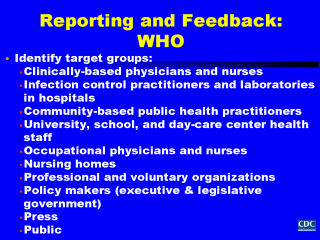Traditionally,
cases of disease or health conditions were reported to surveillance systems by
clinically-based physicians; however, many surveillance systems now rely on information
provided by other health professionals as well such as nurses, infection control
specialists, and public health practitioners in hospitals, laboratories, school and
occupational settings, and nursing homes. In general, the most complete surveillance
systems consist of multiple reporting sources, only some of which are included here.
Summaries of surveillance information should be provided to these types of individuals and
groups who report case information to your surveillance system.
Surveillance information should also be provided to people and
organizations who provide resources important to community-based disease control efforts
(e.g., suppliers of pharmaceuticals and protective gear for investigations of disease
outbreaks and toxic exposures; medical organizations), policy makers, the press, and
anyone else responsible for program and policy development and implementation. And donít
forget to provide information back to members of the public, especially those populations
at highest risk for and/or who have already suffered from the disease or health condition
monitored by your surveillance system.
